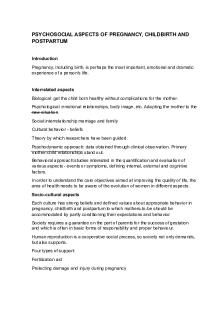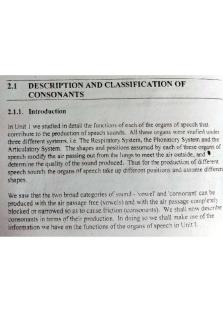Jakobson%2C %27On linguistic aspects of translation%27 PDF

| Title | Jakobson%2C %27On linguistic aspects of translation%27 |
|---|---|
| Course | Inglese |
| Institution | Università degli Studi di Palermo |
| Pages | 3 |
| File Size | 61.3 KB |
| File Type | |
| Total Downloads | 13 |
| Total Views | 144 |
Summary
Alcuni appunti sugli studi sulla traduzione di Jakobson...
Description
Roman Jakobson (1959/2000) ‘On Linguistic Aspects of Translation’, in R. Brower (ed.) (1959) On Translation, Cambridge MA: Harvard University Press, pp- 232-9, reprinted in L. Venuti (ed) (2000), pp. 113-18. We distinguish three ways of interpreting a verbal sign: it may be translated into other signs of the same language, into another language, or into another, nonverbal system of symbols. These three kinds of translation are to be differently labelled. 1)Intralingual translation or rewording is an interpretation of verbal signs by means of other signs of the same language. 2)Interlingual translation or translation proper is an interpretation of verbal signs by means of some other language. 3) Intersemiotic translation or transmutation is an interpretation of verbal signs by means of signs of nonverbal sign systems. The intralingual translation of a word uses either another, more or less synonymous, word or resorts to a circumlocution. Yet synonymy, as a rule, is not complete equivalence, for example, ‘every celibate is a bachelor, but not every bachelor is a celibate.’ Likewise on the level of interlingual translation, there is ordinarily no full equivalence between code units, while messages may serve as adequate interpretations of alien code units or messages. The English word cheese cannot be completely identified with its standard Russian heteronym syr, because cottage cheese is a cheese but not a syr. Russians say: prinesi syru I tvorogu (bring cheese and [sic] cottage cheese). In standard Russian, the food made of pressed curds is called syr only if ferment is used. Most frequently, however, translation from one language into another substitutes Likewise on the level of interlingual translation, there is ordinarily no full equivalence between code units, while messages may serve as adequate interpretations of alien code units or messages. The English word cheese cannot be completely identified with its standard Russian heteronym syr, because cottage cheese is a cheese but not a syr. Russians say: prinesi syru I tvorogu (bring cheese and [sic] cottage cheese). In standard Russian, the food made of pressed curds is called syr only if ferment is used. Most frequently, however, translation from one language into another substitutes messages in one language not for separate code units but for entire messages in same other language. Such a translation is a reported speech; the translator recodes and transmits a message received from another source. Thus translation involves two equivalent messages in two different codes. Equivalence in difference is the cardinal problem of language and the pivotal concern of linguistics. Like any receiver of verbal messages, the linguist acts as their interpreter. No linguistic specimen may be interpreted by the science of language without a translation of its signs into other signs of the same system or into signs of another system. Any comparison of two languages implies an examination of their mutual translatability; widespread practice of interlingual communication, particularly translating activities, must be kept under constant scrutiny by linguistic science. It is difficult to overestimate the urgent need for and the theoretical and practical significance of differential bilingual dictionaries with careful comparative definition of all the corresponding units in their intention and extension. Likewise differential bilingual grammars should define what unifies and what differentiates the two languages in their selection and delimitation of grammatical concepts.
1
Both the practice and the theory of translation abound with intricacies, and from time to time attempts are made to sever the Gordian knot by proclaiming the dogma of untranslatability. “Mr. Everyman, the natural logician,” vividly imagined by B. L. Whorf, is supposed to have arrived at the following bit of reasoning: “Facts are unlike to speakers whose language background provides for unlike formulation of them” (Whorf 1956). In the first years of the Russian revolution there were fanatic visionaries who argued in Soviet periodicals for a radical revision of traditional language and particularly for the weeding out of such misleading expressions as “sunrise” or “sunset.” Yet we still use this Ptolemaic imagery without implying a rejection of Copernican doctrine, and we can easily transform our customary talk about the rising and setting sun into a picture of the earth’s rotation simply because any sign is translatable into a sign in which it appears to us more fully developed and precise. An ability to speak a given language implies an ability to talk about this language. Such a metalinguistic operation permits revision and redefinition of the vocabulary used. The complementarity of both levels – object language and metalanguage – was brought out by Niels Bohr: all well-defined experimental evidence must be expressed in ordinary language, “in which the practical use of every word stands in complementary relation to attempts of its strict definition” (Bohr 1948). All cognitive experience and its classification is conveyable in any existing language. Whenever there is a deficiency, terminology may be qualified and amplified by loanwords or loan translations, by neologisms or semantic shifts, and, finally, by circumlocutions. Thus in the newborn literary language of the Northeast Siberian Chukchees, “screw” is rendered as “rotating nail,” “steel” as “hard iron,” “tin” as “thin iron,” “chalk” as “writing soap,” “watch” as “hammering heart.” Even seemingly contradictory circumlocutions, like “electrical horsecar” ( èlektričeskaja konka), the first Russian name of the horseless streetcar, or “flying steamship” (jeha paraqot), the Koryak term for the airplane, simply designate the electrical analogue of the horsecar and the flying analogue of the steamer and do not impede communication, just as there is no semantic “noise” and disturbance in the double oxymoron — “cold beef-and-pork hot dog.” No lack of grammatical device in the language translated into makes impossible a literal translation of the entire conceptual information contained in the original. The traditional conjunctions “and,” “or” are now supplemented by a new connective“and/or”—which was discussed a few years ago in the witty book Federal Prose—How to Write in and/or for Washington (Masterson, Wendell Brooks 1948). Of these three conjunctions, only the latter occurs in one of the Samoyed languages (Bergsland 1949). Despite these differences in the inventory of conjunctions, all three varieties of messages observed in “federal prose” may be distinctly translated both into traditional English and into this Samoyed language. Federal prose: (1) John and Peter, (2) John or Peter, (3) John and/ or Peter will come. Traditional English: (3) John and Peter or one of them will come. Samoyed: (1) John and/ or Peter, both will come, (2) John and/ or Peter, one of them will come. If some grammatical category is absent in a given language, its meaning may be translated into this language by lexical means. Dual forms like Old Russian brata aretranslated with the help of the numeral: “two brothers.” It is more difficult to remain faithful to the original when we translate into a language provided with a certain grammatical category from a language devoid of such a category. When translating the English sentence She has brothers into a language which discriminates dual and plural, we are compelled either to make our own choice between two statements “She has two brothers”—“She has more than two” or to leave the decision to the listener and say: 2
“She has either two or more than two brothers.” Again, in translating from a language without grammatical number into English, one is obliged to select one of the two possibilities—brother or brothers or to confront the receiver of this message with a twochoice situation: She has either one or more than one brother. As Franz Boas neatly observed, the grammatical pattern of a language (as opposed to its lexical stock) determines those aspects of each experience that must be expressed in the given language: “We have to choose between these aspects, and one or the other must be chosen” (Boas 1938). In order to translate accurately the English sentence I hired a worker, a Russian needs supplementary information, whether this action was completed or not and whether the worker was a man or a woman, because he must make his choice between a verb of completive or noncompletive aspect—nanjal or nanimal—and between a masculine and feminine noun—rabotnika or rabotnicu. If I ask the utterer of the English sentence whether the worker was male or female, my question may be judged irrelevant or indiscreet, whereas in the Russian version of this sentence an answer to this question is obligatory. On the other hand, whatever the choice of Russian grammatical forms to translate the quoted English message, the translation will give no answer to the question of whether I hired or have hired the worker, or whether he/she was an indefinite or definite worker (a or the). Because the information required by the English and Russian grammatical pattern is unlike, we face quite different sets of two-choice situations; therefore a chain of translations of one and the same isolated sentence from English into Russian and vice-versa could entirely deprive such a message of its initial content. The Geneva linguist S. Karcevskij used to compare such a gradual loss with a circular series of unfavorable currency transactions. But evidently the richer the context of a message, the smaller the loss of information. Languages differ essentially in what they must convey and not in what they may convey. Each verb of a given language imperatively raises a set of specific yes-or no questions, as for instance, is the narrated event conceived with or without reference to its completion? Is the narrated event presented as prior to the speech event or not? Naturally the attention of native speakers and listeners will be constantly focused on such items as are compulsory in their verbal code.
3...
Similar Free PDFs

Legal Aspects of Nursing
- 5 Pages

Behavioural Aspects of Budgeting
- 7 Pages

Psychosocial Aspects OF Pregnancy
- 19 Pages

MCQ - Legal Aspects of Business
- 25 Pages

Nine Aspects of Beliefs Summary
- 2 Pages

Aspects of language meg-4
- 7 Pages

Belbin’s aspects of team working
- 4 Pages

Legal Aspects of Business MCQs
- 26 Pages

TOPIC 1. Aspects of Marketing
- 14 Pages
Popular Institutions
- Tinajero National High School - Annex
- Politeknik Caltex Riau
- Yokohama City University
- SGT University
- University of Al-Qadisiyah
- Divine Word College of Vigan
- Techniek College Rotterdam
- Universidade de Santiago
- Universiti Teknologi MARA Cawangan Johor Kampus Pasir Gudang
- Poltekkes Kemenkes Yogyakarta
- Baguio City National High School
- Colegio san marcos
- preparatoria uno
- Centro de Bachillerato Tecnológico Industrial y de Servicios No. 107
- Dalian Maritime University
- Quang Trung Secondary School
- Colegio Tecnológico en Informática
- Corporación Regional de Educación Superior
- Grupo CEDVA
- Dar Al Uloom University
- Centro de Estudios Preuniversitarios de la Universidad Nacional de Ingeniería
- 上智大学
- Aakash International School, Nuna Majara
- San Felipe Neri Catholic School
- Kang Chiao International School - New Taipei City
- Misamis Occidental National High School
- Institución Educativa Escuela Normal Juan Ladrilleros
- Kolehiyo ng Pantukan
- Batanes State College
- Instituto Continental
- Sekolah Menengah Kejuruan Kesehatan Kaltara (Tarakan)
- Colegio de La Inmaculada Concepcion - Cebu






